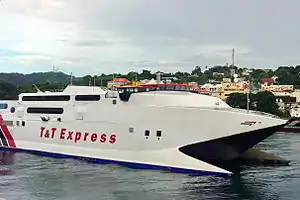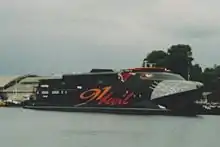HSC INCAT 046
HSC INCAT 046 is a wave-piercing catamaran passenger-vehicle ferry. It has operated under various marketing names, including Devil Cat, The Cat, The Lynx, and now The T&T Express.
 | |
| History | |
|---|---|
| Name: | INCAT 046 |
| Operator: |
|
| Route: | Port of Spain - Scarborough |
| Builder: | Incat, Tasmania, Australia |
| Yard number: | 046 |
| Laid down: | 17.2.1997 |
| Launched: | 20.9.1997 |
| Commissioned: | 12.1997 |
| Homeport: | Nassau, Bahamas |
| Identification: |
|
| Status: | Out for Repairs [1] |
| Notes: | Classification: DnV +1A1 HSLC R1 Car Ferry |
| General characteristics | |
| Type: | High-speed craft |
| Tonnage: | 5,617 GT |
| Length: | 91.3 m (299 ft 6 in) |
| Beam: | 26 m (85 ft 4 in) |
| Draught: | 3.7 m (12 ft 2 in) |
| Ramps: | Stern Ro-Ro loading |
| Propulsion: | 4 × Ruston 20 RK 270 medium-speed diesel engines, 38,000 bhp (28,337 kW) |
| Speed: | 43 knots (80 km/h; 49 mph) |
| Boats & landing craft carried: | 10 × 100-person life rafts, 4 escape slides |
| Capacity: |
|
| Crew: | 22 |
Vessel characteristics
HSC INCAT 046 is a 91-metre vessel built by InCat Australia in Hobart, Tasmania in 1997 as hull 046. She is a sister ship to HSC Express (holder of a Trans-Atlantic speed record), HSC Max Mols and HSC Master Cat, all of which are Incat91 models.
INCAT 046 is constructed from marine grade aluminium alloys. Each water-borne hull is subdivided into multiple watertight compartments connected by an arched bridging structure with a central forward hull above the smooth water line. Each water-borne hull carries two engines which drive water jets mounted on the transom.
Vehicles are stowed in and between both waterborne hulls in a configuration of rising and descending decks which load from a single level transfer bridge at the stern. The main passenger deck is immediately above the vehicle decks and consists of a cafe, gift shop, children's play area and passenger seating lounges, as well as an outside observation deck that runs the width of the ship at the stern. The passenger seating lounges have overhead television monitors which play movies, or television broadcasts, as well as a continuously updated map showing the vessel's GPS coordinates. A smaller secondary passenger deck is located one deck up and has a bar immediately aft of the wheelhouse.
Service history

TT-Line (1997–1998, 2000–2001, 2001–2002)
HSC INCAT 046 was constructed for TT-Line and operated across Australia's Bass Strait on the world's longest distance high speed ferry service (marketed as Devil Cat), between Station Pier, Port Melbourne, Victoria to The Esplanade, George Town, Tasmania.[2] Typical service speed was 80 km/h with fares averaging $100 (AUD) one-way in peak season (Dec-Jan) and $92 one-way in shoulder season (Jan-Apr). Weather conditions in the Bass Strait often led to cancellation during storms and heavy seas, with five cancellations in the first ten weeks of operating.[2] The vessel's ride during choppy conditions led to its nickname "Spew Cat". The ship was sold to Bay Ferries after the first season, but during the 2000-2001, 2001–2002 summer peak periods it was charted to again run the George Town–Station Pier route as the Devil Cat.

Bay Ferries (1998–2002)
The INCAT 046 was sold to Bay Ferries in 1998 for service on that company's Gulf of Maine route between Yarmouth, Nova Scotia and Bar Harbor, Maine under the marketing name The Cat. The vessel departed Hobart on April 26, 1998, arriving in Yarmouth on May 20, 1998 to great fanfare from American and Canadian news media.
On September 4, 1998, the vessel collided with a fishing boat in Yarmouth Harbour in thick fog. The vessel was heading out of the harbour when it collided with the "Lady Megan II", which was entering the harbour after a two-day fishing trip on Georges Bank. The vessel crushed the smaller fishing boat, killing the captain, however the three crew members survived.[3]
The vessel operated seasonally on the Yarmouth–Bar Harbor route from May–October. HSC INCAT 046 was sold in early 2002 to Incat as a trade-in by Bay Ferries for the newer and larger capacity HSC The Cat (which in the case of this vessel, is its official registered name).
Interisland Line (2002–2003)
The vessel was leased by Incat to the Interisland Line, a New Zealand company, for which it was used in the Cook Strait that year, using the marketing name The Lynx, however operating issues relating to its wake saw the vessel returned to Incat in early 2003 where it was laid up in Hobart.
Bay Ferries (2003–2006)
Bay Ferries subsequently repurchased the vessel and leased it under a wet charter (crewed and operated by Bay Ferries) for a route in Trinidad and Tobago between Port of Spain and Scarborough. Bay Ferries maintained the Interisland Line's marketing graphics on the vessel and referred to it as The Lynx during this period.
Government of Trinidad and Tobago (2006–present)
The vessel was purchased from Bay Ferries by the Government of Trinidad and Tobago's Ministry of Works and Transport in 2006. She maintains the official registered name of INCAT 046 but is marketed as the T&T Express and is operated by Bay Ferries Management Ltd. on behalf of the government. She operates the interisland service between Port of Spain and Scarborough in conjunction with the HSC T&T Spirit.
Sister ships
- HSC Express, operated by P&O Irish Sea.
- HSC Max Mols, operated by Mols Linien.
- HSC Fjord Cat
References
- . The Trinidad and Tobago Guardian. 20 March 2018 http://www.guardian.co.tt/news/2018-03-19/seabridge-back-normal-friday. Retrieved 20 March 2018. Missing or empty
|title=(help) - "Cat chief defends disrupted service". The Examiner. 31 March 1998. Retrieved 30 January 2015.
- Marine Investigation Report M98M0061
